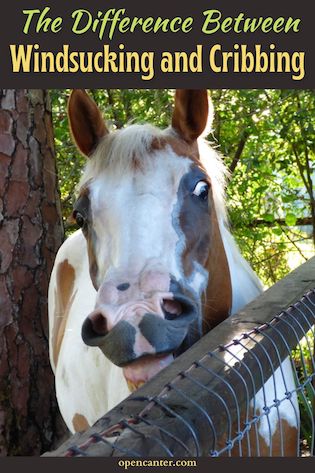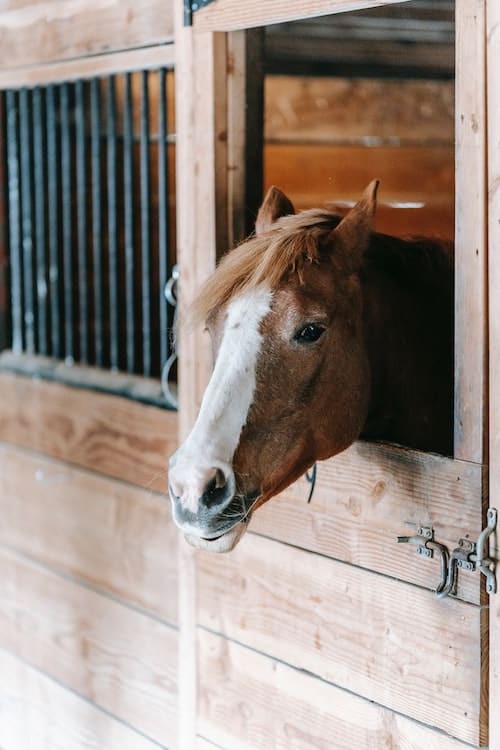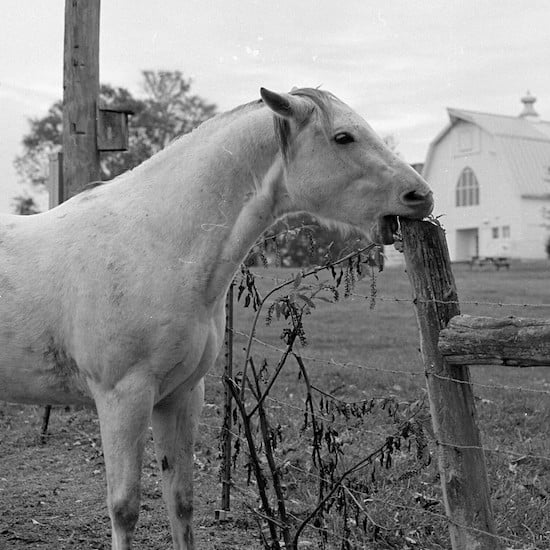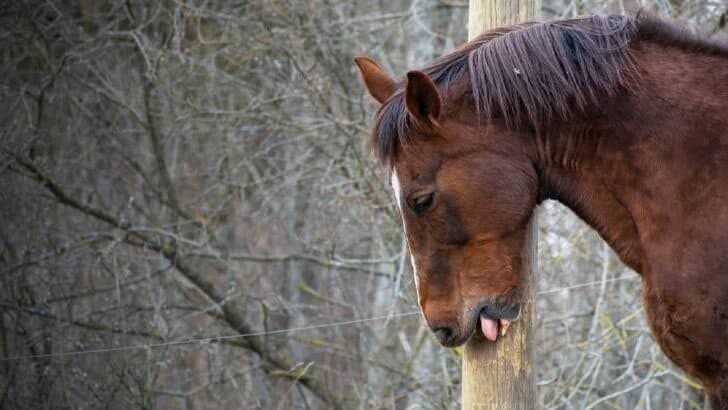Affiliate Disclaimer
As an Amazon Associate I earn from qualifying purchases. It helps me keep the website going. Thank you for your support.
Windsucking and cribbing, or crib biting are both stereotypies. Stereotypic behavior is an action that horses repeat in a compulsive, habitual way. There are some similarities between these two stable vices, but they are not quite the same thing. So, what is the difference between windsucking and cribbing? Let’s take a look…
Windsucking and cribbing both involve the horse swallowing or gulping down air into their stomach. The difference is that when a horse cribs they latch their top teeth onto a solid object like a fence post. They then pull on the object with their teeth and swallow air. Windsucking is a similar swallowing action, but without hooking their teeth on an object.

Some Similarities Between Windsucking and Cribbing
Windsucking and cribbing are often accompanied by a burping or grunting noise made by the horse as they draw in the air. With some horses, this grunting noise is quite loud, and for others, it’s reasonably quiet. Nevertheless, the noise can be quite annoying, particularly if you as an owner are sensitive to sounds.
Another similarity between windsucking and cribbing is that the jury is still out on the exact underlying cause. It’s thought that both of these stereotypic behaviors can be the result of a combination of factors.
Some of these factors include:
- Boredom – It’s thought that horses turn to windsucking or cribbing to alleviate the boredom of being in a stable. Often horses will rely on these vices less if they are turned out to pasture for longer periods of time.
- Isolation – Horses are sociable animals who need company. The stress and distress of isolation are thought to be a causal factors in the development of a stable vice.
- Stomach discomfort – Horses have high stomach acid, and they need to graze on forage throughout the day. This helps them to neutralize the acid levels in their tummies. If a horse doesn’t have regular access to forage this can cause stomach discomfort. It’s thought that windsucking and cribbing can be a response to this discomfort.
- An Inherited Predisposition – There is some thinking that particular breeds of horses have a higher inherited predisposition to rely on vices like windsucking and cribbing than others. Research indicates that some horses are hardwired to cope with stressful situations in this way (source).
Another similarity between windsucking and cribbing is that with some horses it’s possible to reduce the amount of time they spend practicing these vices. A change in routine, good stable management, and attention to the horse’s diet and supplements can make a difference.
But this is not always the case. Some horses are inveterate windsuckers or cribbers and regardless of what you do, they will continue with the behavior come what may.
Are Windsucking and Cribbing Actually Different?
The terms windsucking and cribbing are often used interchangeably. Many reputable equestrians will use these terms to refer to the same thing.
Usually, if they are being used in the same way, they are both used to refer to when a horse latches its teeth on an object and pulls.
An example of the two terms being used in the same way is found in The Complete Horse Care Manual by the vet Colin Vogel. He states that:
‘Windsucking is a vice where the horse fixes its upper teeth and lower jaws around a solid object and “swallows” air (page 47). By contrast, he refers to crib biting as when the ‘horse grinds its incisor teeth on a solid object, most commonly the top edge of the lower stable door’ (page 46), (source).
By contrast, The Complete Book of Horses, by Sly, Muir, and Draper states that:
With windsucking ‘the horse sucks in air and swallows it’. Whereas crib-biting is ‘similar to windsucking except that the horse will also take hold of an object with his teeth’ (page 491).
Differences Between Windsucking and Cribbing
As you can see these terms are often used in various ways by different experts. So, I did what I always do when I want an opinion, and I asked my vet. This is what she had to say on the difference between windsucking and cribbing…
Both windsucking and cribbing or crib biting involve gulping or swallowing air. This is why they are often used in the same way. However, her opinion was that involves the horse hooking their teeth into an object and pulling. This is usually a wooden fence post, but they can also use a metal stable door or even a solid water trough.
Horses can also crib bite on trees. This may look like they are eating bark, but they are using the tree as a lever. Horses do however sometimes eat tree bark. If you are concerned that your horse is eating tree bark, you can read more about that here.
My vet went on to say that it’s thought that repetitive behaviors of this kind release stress-busting hormones for the horse. These hormones include endorphins and dopamine. Interestingly these are the same hormones that are released for humans when they engage in some sort of habitual behavior like frequently checking cell phones!
Once a horse falls into a habit like crib biting, it can be a hard habit for them to break. This is because they get a little burst of feel-good hormones in their body and brain when they engage in the behavior (source).
It’s thought that horses get a similar feel-good buzz from windsucking. The difference is that when they windsuck, they don’t need a solid object to fix their teeth. They will have the same bodily posture and the same action of swallowing air. However, they do this by flexing or arching their neck and sucking in air without pulling on an object.

The Disadvantages of Windsucking and Cribbing
There has been some thought recently that the term ‘stable vice’ is a bit outdated. The word ‘vice’ seems to imply some sort of blame on the horse for engaging in ‘poor’ habits.
But it’s recently been acknowledged that ‘vices’ of this kind are the way that horses adapt to the sometimes stressful environments that humans create for them.
That being said, these adaptive behaviors do have consequences for the horse, and their owner. Here are some of the issues that can be caused by windsucking and cribbing…
Problems Linked to Cribbing
- A horse can destroy fence posts and stable doors when they repeatedly bite on them
- Horses that have cribbed for a long time can have significant wear to their teeth
- Worn teeth can make it harder for horses to chew and digest forage and feed
Problems Linked to Windsucking
- Windsucking can be harder to manage in that the horse doesn’t need a solid object to latch onto. As a result, a horse can windsuck anywhere and for this reason, can be a little harder to manage.
As such, cribbing has some additional disadvantages that are not necessarily an issue with a horse that windsucks.

Difficulties Associated with Both Windsucking and Cribbing
Nevertheless, both of these behaviors are associated with issues that can arise whether the horse is latching their teeth or not. Here are some of the shared disadvantages of both windsucking and cribbing.
- Difficulty in gaining and keeping weight on: It can be harder for your horse put weight on and maintain a good condition. This is in part because horses can get distracted windsucking or cribbing rather than grazing.
- Colic: Some researchers have linked windsucking and cribbing to an increased chance of a horse colicking. Not all vets and specialists agree that there is a causal link, but many do.
- Equine gastric ulcers : There is some thought that windsucking and cribbing are linked to the development of gastric ulcers in horses. Some vets believe that horses can develop these vices to cope with the discomfort of ulcers. Equally, it’s thought that ulcers may be triggered when horses are caught up in habitual behavior rather than grazing.
- Accommodation: It can be harder to stable a horse that windsucks or crib bites. This is partially because yard owners can be nervous about accepting a horse with a vice. Although there is no systematic evidence that horses copy vices from one another, it is still something that horse owners worry about.
- Harder to Sell: Some owners find it harder to sell horses that have a vice such as windsucking or cribbing. Should the time come when you want to sell your horse, you may find that stereotypic behavior will affect the price you can ask.
- Impact on insurance: Because windsucking and cribbing have been linked to health issues, this can sometimes increase your insurance premium. You might even find that certain exclusions apply to your policy if the vice was a pre-existing behavior.
Final Thoughts
Windsucking and crib biting are very similar behaviors thought to be stress responses in horses triggered by environmental factors. The main difference between windsucking and cribbing is the use of the horse’s teeth to gain leverage when crib biting. This, in turn, causes greater damage to fences, posts, and stable doors, and potentially damages the horse’s teeth.




